Silk is an expensive textile fibre. India is the second largest silk producer and the largest consumer in the world. India is also the biggest importer of silk goods. The demand of silk goods is so high that India needs to import large quantity of raw silk to meet the domestic demand. Silk sarees have high domestic demand. India produces four different types of natural silks—mulberry, eri, tasar and muga. Indian silk export items are silk garments, made-ups, fabrics, yarns, carpets and various handmade and handicrafts products. Mulberry silk is the most popular variety of silk produced in India, with Karnataka, Tamil Nadu, Andhra Pradesh, West Bengal and Jammu Kashmir being the major raw silk producing states. Muga is the most expensive silk. Indian silk industry employs a large number of people, who are engaged from raw silk cultivation to production of silk goods and marketing activities.
The share of mulberry silk goods is to the extent of 95 per cent, while other silk items such as tasar and mixed silk fabrics together contributed 5 per cent of India’s total silk export during 1990-2000. The growth rates for quantity and value of export for all mulberry silk goods together were estimated to be 0.49 and 7.98 per cent during the same period. Dress material and readymade garments put together shared 62.37 per cent of total export value during 1990-1991, but their share declined to 60.42 per cent in 2000-2001.
The growth rates of country-wise export earnings showed that Hong Kong, France and Italy were 16.04, 13.95 and 10.00 per cent during the period from 1990-91 to 1999-2000. India has huge potential for increasing export earnings as it has better comparative advantages compared to China, which is the largest silk producer. Therefore, India has to make more efforts in increasing quality silk production to meet the growing domestic and export demands of silk products in near future.
The Indian silk export sector has been growing considerably, but it is in a situation where both prospects and problems exist simultaneously. The industry showed an impressive growth in export in last two decades. It is due to the silk exporters’ marketing skills and good understanding of the international markets. In recent years, the Indian Silk Promotion Council has organised Buyer-Seller-Meets (Indian Silk Shows) in countries such as Morocco, Greece, and Lebanon. High quality of indigenous mulberry raw silk and optimum price of imported mulberry raw silk together with good export production and marketing efforts are required to improve the silk export in India.
Figure 1 explains the value of exports from India in the year 2022. Fabric made-ups and readymade garments had the largest share with export value of $112.41 million and $90.42 million respectively in the year 2022. Silk waste and silk carpets had export value of $28.02 million and $10.63 million respectively. Silk yarn and silk cocoons were the other two silk items exported in the year 2022.
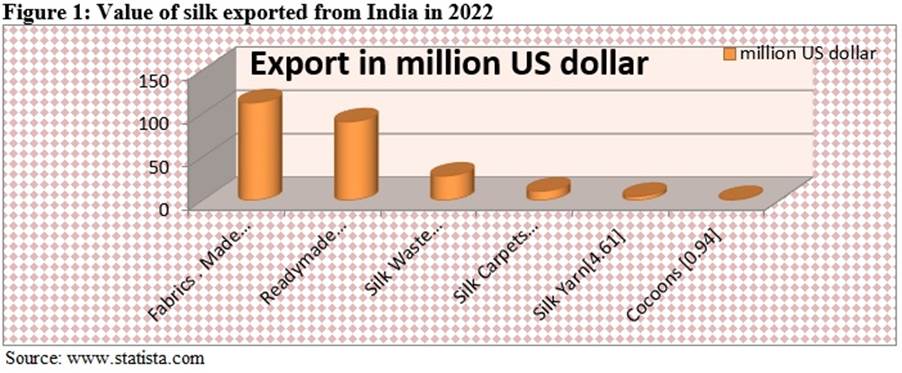
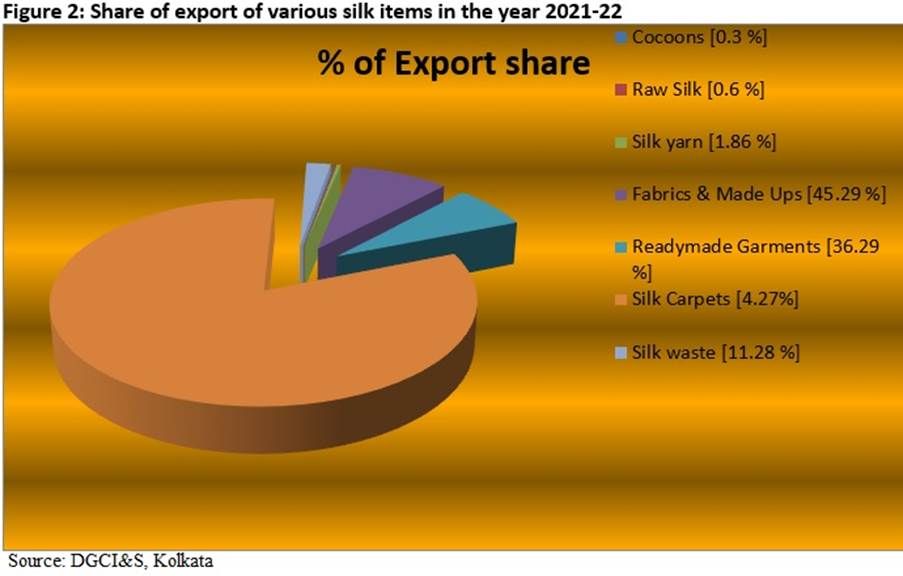
Figure 2 explains that fabrics & made-ups was the largest export item from India in the year of 2021-22, having an export share of 45.29 per cent. Readymade garments and raw silk were the second and third largest items of silk export having a share of 36.29 per cent and 11.28 per cent respectively. Silk carpets, silk yarn, raw silk and silk cocoons were the other important export items from India during the period.
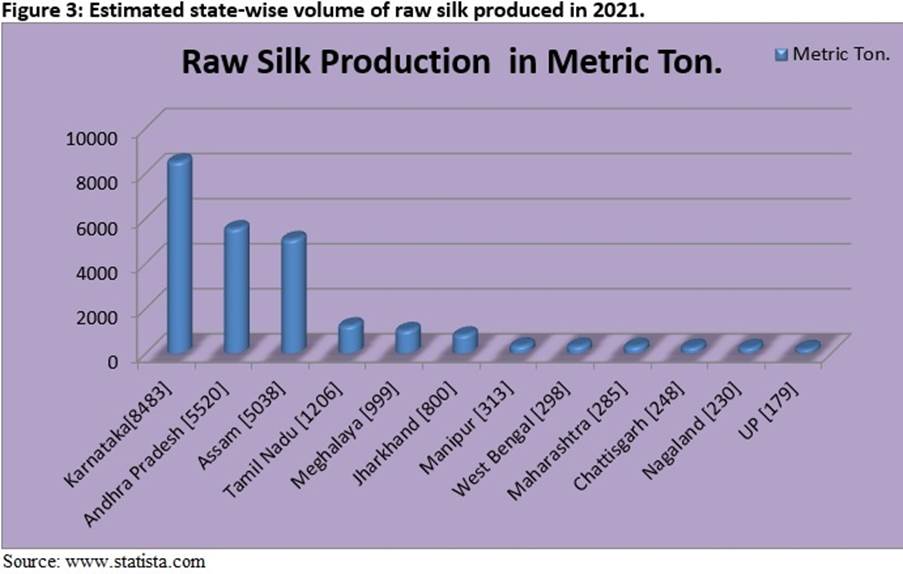
Figure 3 explains that in the year 2021, raw silk production was highest in the state of Karnataka at 8,486 mt. Andhra Pradesh and Assam were the second and third largest silk producers with 5,520 mt and 5,038 mt respectively. Tamil Nadu and Meghalaya were the fourth and fifth largest raw silk producing states.
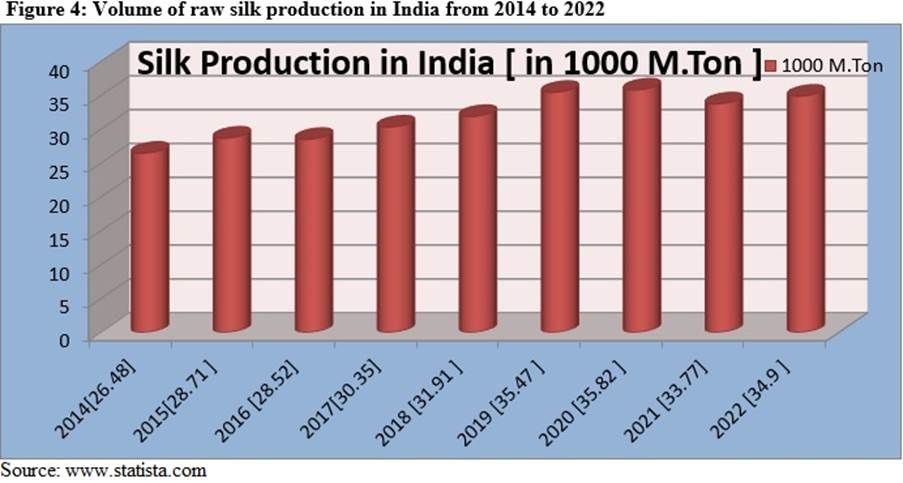
As per Figure 4, the total quantity of raw silk production increased from 26,480 mt in 2014 to 34,900 mt in 2022. Maximum raw silk production of 35,820 mt was registered in 2020. This is a good sign for the Indian silk industry, as rising trend of raw silk cultivation enhanced the prospects of raw silk production and employability of people in our country.
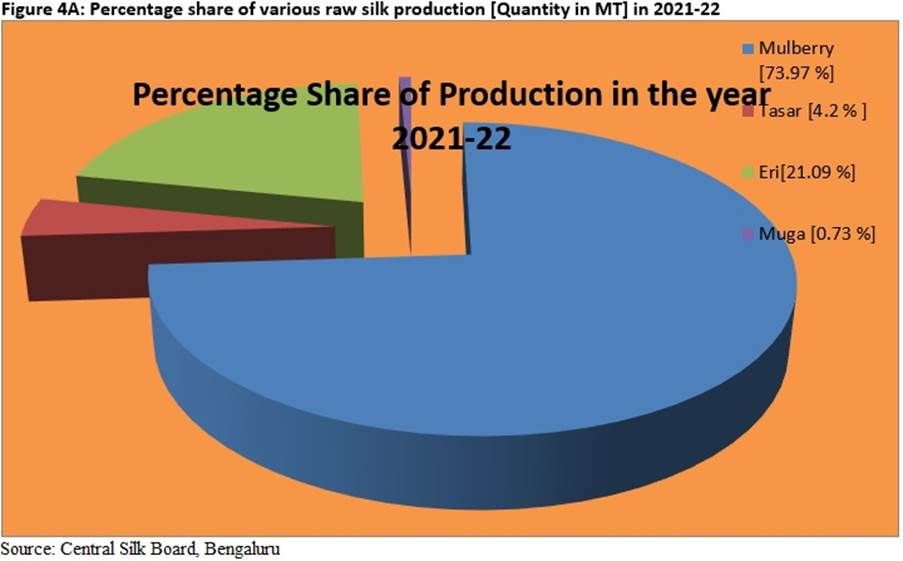
Figure 4A explains that 4 types of raw silk were produced in our country in 2021-22. Mulberry was the major silk produced with 73.97 per cent of the total silk production. Eri was the second largest type of raw silk produced in our country at 21.09 per cent. Tasar and muga had a share of 4.2 per cent and 0.73 per cent respectively.
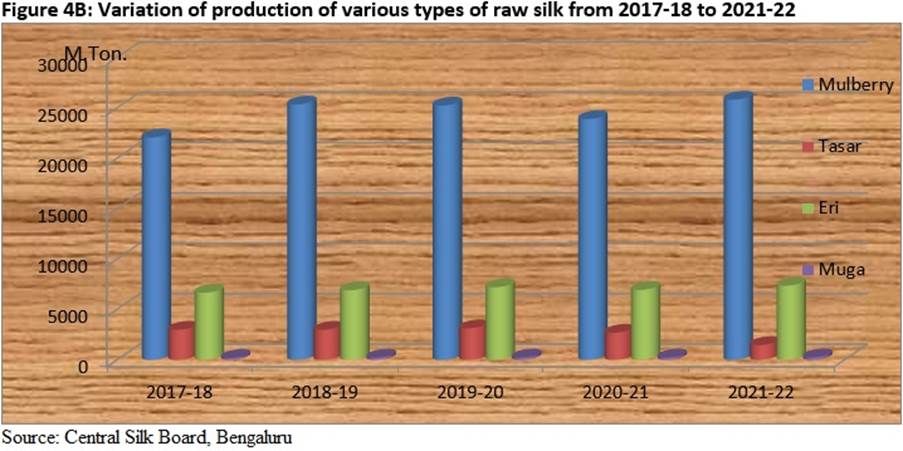
As seen in Figure 4B, mulberry silk was the largest raw silk produced in India having quantity of more than 25,000 mt in 2021-22. The mulberry silk production was much higher in the year 2021-22 compared to 2020-21. Eri was the second largest raw silk production in India at 5,000 mt. The production of tasar silk decreased in 2021-22 compared to 2020-21.
 Figure 5 shows Indian silk export earnings increased in the year 2021-22 compared to 2020-21. However, the export earning witnessed a decreasing trend from the year 2018-19 to 2020-21 due to pandemic situation.
Figure 5 shows Indian silk export earnings increased in the year 2021-22 compared to 2020-21. However, the export earning witnessed a decreasing trend from the year 2018-19 to 2020-21 due to pandemic situation.
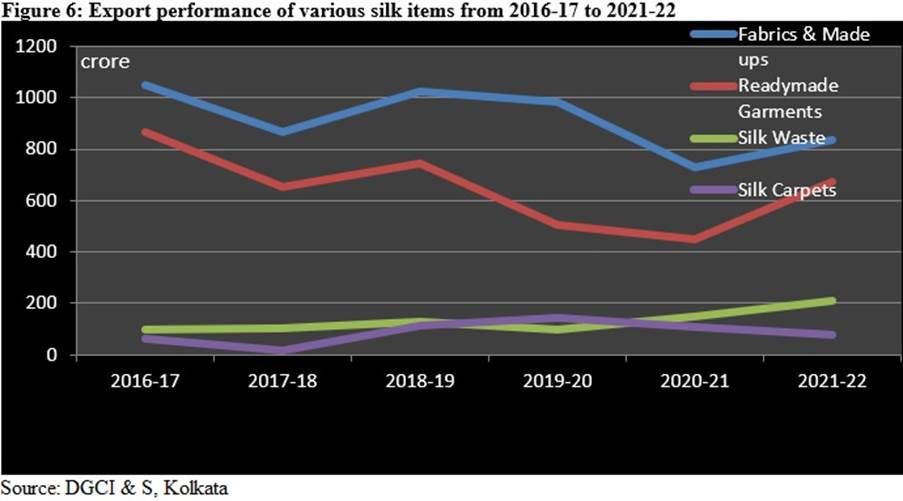
Figure 6 shows the export performance of various silk items over different financial years. Only silk waste has increasing trend in export value from the year 2016-17 to 2021-22. Fabrics & made-ups was the largest export item among the silk goods, but shows decreasing trend of export value from 2016-17 to 2020-21. But it increased to ₹800 crore in 2021-22. Readymade garments was the second largest silk export item from India earning more than ₹600 crore in 2021-22. Due to pandemic situation, the export value had reached below ₹500 crore in 2020-21.
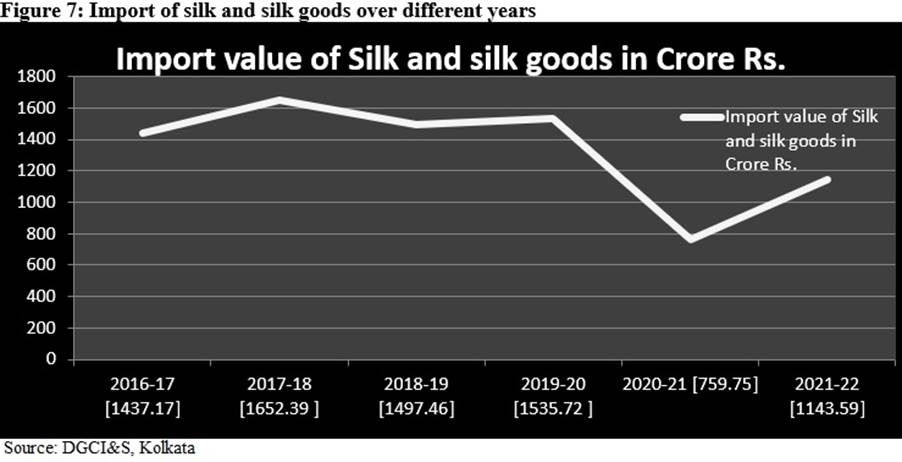
As can be seen in Figure 7, the value of silk and silk goods imports is showing a decreasing trend. In 2017-18, the total import value was more than ₹1,600 crore, which decreased to ₹800 crore in 2020-21, which was mainly due to the pandemic situation. Import value reached to more than ₹1,100 crore in 2021-22.
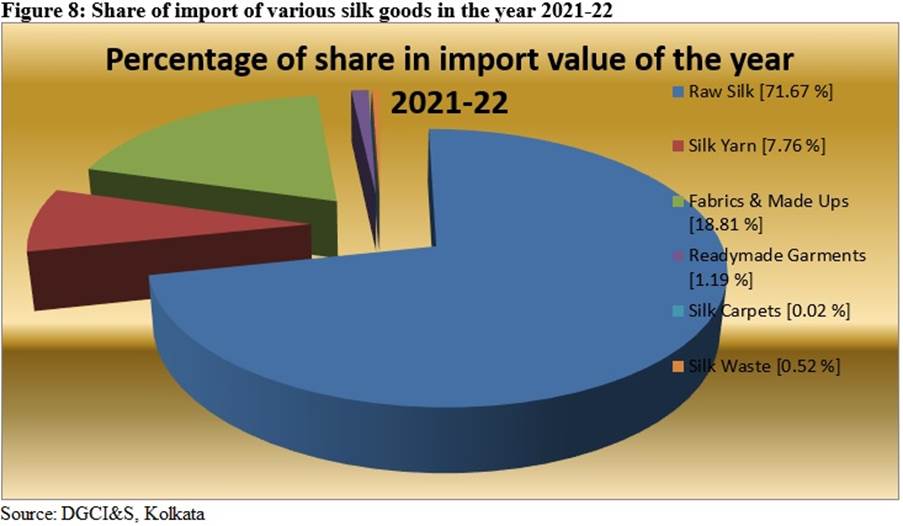
According to Figure 8, raw silk was the major import item having a share of 71.67 per cent in the year of 2021-22. Fabrics & made-ups was the second largest import value item having a share of 18.81 per cent, followed by silk yarn with 7.76 per cent share. Other silk items that were imported were readymade garments, silk carpets and silk waste.
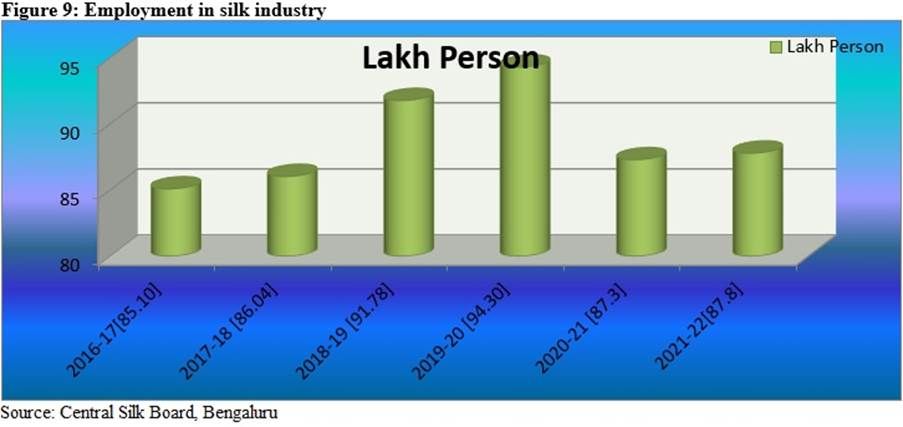
Figure 9 explains the employment in silk industry from 2016-17 to 2021-22. In the year 2016-17, 85.10 lakh persons were engaged in the silk industry, whereas the figure was 87.8 lakh persons in 202r1-22. However, the number was highest at 94.3 lakh persons in 2019-20. Due to pandemic situation, the number of persons engaged in the silk industry decreased to 87.3 lakh in 2020-21.

Table 1 shows the variation in price of different types of raw silk from 2016-17 to 2021-22. The price of the most expensive raw silk muga (warp) was ₹19,800 per kg in 2021-22, which is an increase of 66.6 per cent over the rice in 2016-17. The price of mulberry raw silk price increased by 15.95 per cent to ₹3,421 per kg in 2021-22 compared to 2016-17. Likewise, the price of eri (spun yarn) increased to ₹2,900 per kg in 2021-22, an increase of 11.5 per cent compared to 2016-17.
Challenges of Indian silk industry
Following challenges are observed in Indian silk industry:
• Demand of silk products is decreasing in Europe and the US.
• Price of raw silk and fabric are rising.
• Competition with synthetic fibre industry is increasing.
• Competition is also observed with silk blended fibres.
• High quality raw silk availability is decreasing in the Indian market.
• There is competition with China in high quality raw silk and silk products.
Government initiatives for improvement
The ministry of textiles, Government of India, has been taking the following steps through the Central Silk Board (CSB).
1. Silk Samagra is an initiative for development of sericulture in the country. The main objective of the scheme is to focus on improvement of quality and productivity of raw silk. It helps to reduce the import of raw silk.
2. North Eastern Regional Textile Promotion scheme implemented 38 sericulture projects. The projects are applicable for Regional Development of North Eastern States.
3. To improve quality and productivity of silkworm/host plant etc, Research and Development cell has been set up.
4. Automatic reeling machine units have been established in specialised areas for production of International Standard Silk of 3A and 4A grades.
5. National Rural Employment Guarantee Act and Rashtriya Krishi Vikash Yojana are being implemented to help silk farmers in rural areas.
6. Integrated Scheme for Development of Silk Industries [ISDSI], was implemented by Govt. of India through the Central Silk Board (CSB). The aim of the scheme was to grant ₹2161.68 crore for three years from 2017-18 to 2019-20 for overall development of silk industry in the country. The objective of the scheme was to improve quality and productivity along with R&D, training, transfer of technology, and information technology initiatives.
7. The National Silk Policy 2020 is currently running. Its main features are:
• Improvement of seed organisation.
• Improvement of coordination and market development.
• Implementing Quality Certification System [QCS] / Export brand promotion, and Technology upgradation.
• Upscaling of wet processing and weaving sections.
• Product diversification.
• Upscaling of mulberry reeling units.
• By-product utilisation.
• Integrated farming systems.
• Effluent treatment system implementation.
• Information Technology interventions
• Export promotion of Indian silk products and raw silk.
• Brand promotion of Indian silk.
• Duty exemption on silk machinery.
• Foreign Direct Investment [FDI] in sericulture.
Conclusion
India is the second largest producer of raw silk in the world. The Indian silk industry employs around 9.76 million people. However, the industry faces many challenges, including price fluctuation of raw silk, and competition from synthetic fibres. The Government of India is currently implementing National Silk Policy 2020, which is helping the silk industry to overcome these challenges.







Comments